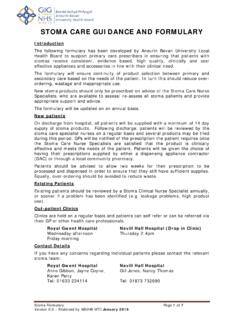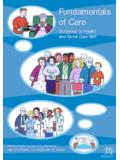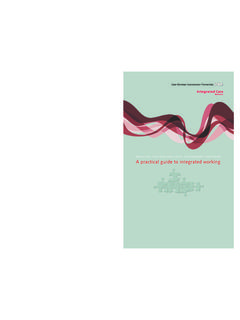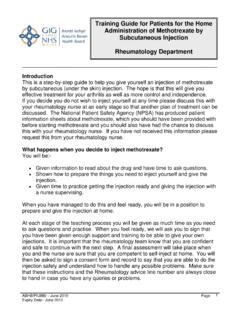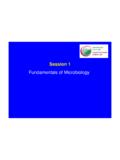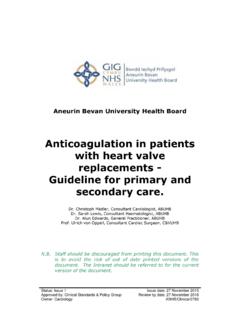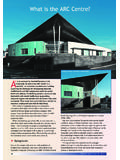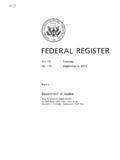Transcription of Strategy for the Safe Handling and Disposal of Waste
1 Ceredigion and Mid Wales NHS Trust Version Policy for the safe Handling and Disposal of hazardous Waste Page 1 YMDDIRIEDOLAETH GIG CEREDIGION A CHANOLBARTH CYMRU CEREDIGION AND MID WALES NHS TRUST Strategy for the safe Handling and Disposal of Waste Author Hotel Services Manager Equality impact (L) Original Date February 1999 This Revision December 2005 Equality assessment done 9 Initial screening: Yes Full Impact Assessment No Next Review Date December 2008 Review Body Environment & Waste Group Approved by Management Board Policy Number CS11 Date of Approval February 2006 Classification Corporate Strategy Ceredigion and Mid Wales NHS Trust Version Policy for the safe Handling and Disposal of hazardous Waste Page 2 CONTENTS PAGE: Page 1. Introduction 4 2. Responsibilities 5 3.
2 Reporting procedures 6 4. Legal Requirements and Guidance 6 5. Waste Categorisation 8 6. Handling Requirements 9 7. Documentation 9 Transfer notes Consignment notes Licences Site as hazardous Waste Site Duty of Care Visits Waste Management Exemption Licence 10 10 11 11 11 8. Accidents and Incident Reporting 11 9. Risk Assessment 12 10. Waste Reduction and Recycling 12 PART 2: GUIDELINES FOR safe Disposal OF Waste 1. Means of Segregation 13 2. Specification for Containers and Enclosures to be Used 14 Waste Containers Sharps Clinical Waste Sacks Placenta Boxes and Medi Bins 14 14 14 15 3. Storage 16 4. Transport 17 5. Handling and Disposal 18 a) b) c) d) e) f) g) h) i) j) k) Clinical Waste Placenta Limbs and Anatomical Waste Clinical Waste from Isolation Rooms hazardous Waste from Isolation Rooms Laboratory Waste - Breakdown of Autoclaves Sharps Cytotoxic/Cytostatic Pharmaceutical Aerosol Cans Batteries 18 18 18 19 19 19 21 21 21 21 22 Ceredigion and Mid Wales NHS Trust Version Policy for the safe Handling and Disposal of hazardous Waste Page 3 l) m) n) o) p) q) r) s) t) u) v) w) x) y) Fluorescent Tubes Oils Paints and Solvents Electrical Equipment Soot Mercury and Amalgam Asbestos Furniture Construction & Demolition Waste Glass and Aluminium Confidential Waste Food Waste Packaging Ground Waste 22 22 22 22 23 23 24 24 24 24 25 25 25 25 6.
3 Final Disposal 25 7. hazardous Waste External Contractors 26 8. Training Needs 27 9. Personal Protective Equipment 28 APPENDIX I Pharmacy Dept Waste Disposal 30 II Action Following Accidental Spillages 35 III safe Use, Handling , Disposal of Sharps Form 1: Sharps/Body Fluid Contamination Risk Assessment Form Form 2: Patient Consent Form (For use after sharps injury) 38 41 42 IV Discharge to Sewers 43 V Disposal of Waste Pathology Dept 44 VI Disposal of hazardous Waste in the Community Health Service 46 VII Disposal of hazardous Waste - Ambulance Services 50 SUMMARY GUIDE TO Waste Disposal 51 ORGANISATIONAL CHART 54 Ceredigion and Mid Wales NHS Trust Version Policy for the safe Handling and Disposal of hazardous Waste Page 4 1. Introduction The Facilities Directorate of Ceredigion and Mid Wales NHS Trust is responsible for Waste management on behalf of the Trust.
4 Waste management must be viewed as a priority throughout NHS Trusts: internal standards are established through the Welsh Risk Management Standards, Standards for Better Health and the NHS Environmental Assessment Tool (NEAT), and guidance documentation must also be considered. The health and safety of our employees, patients and visitors must also remain a primary consideration. Waste must be managed, handled and disposed of in a manner that ensures: 1. Risks to health, safety and the environment are controlled. 2. All applicable legislation is complied with. 3. The most viable Disposal options are selected. This Strategy is designed to enable delivery of the following specific Waste management aims: To ensure that Waste is segregated in an effective manner that meets the requirements of legislation.
5 To minimise all Waste arisings. To ensure the safety of staff, patients and visitors. To ensure protection of the environment To ensure protection against scavenging, infestation and human interference. To meet the requirements of other Trust policies, NHS guidance, standards and legislation. The document therefore sets out the position and management arrangements within the Trust that will ensure effective Waste management throughout. This includes the establishment of clear responsibilities, and documenting performance requirements in key areas, and particularly in relation to the segregation, storage, Handling , transportation and Disposal of Waste . High standards of Waste management will not be achieved without thorough training for all relevant staff. Ceredigion and Mid Wales NHS Trust Version Policy for the safe Handling and Disposal of hazardous Waste Page 5 Definitions Waste : any substance or object which the holder discards or intends or is required to discard.
6 An accepted definition of the legal status of clinical Waste is: a) Any Waste which consists wholly or partly of human or animal tissue, blood or other body fluids, excretions, drugs, or other pharmaceutical products, swabs or dressings or syringes, needles or other sharp instruments being Waste which unless rendered safe may prove to be hazardous to any persons coming into contact with it. b) Any other Waste arising from medical, nursing, dental and vetinary, pharmaceutical or similar practice, investigation, treatment, care, teaching or research, or blood from transfusion, being Waste which may cause infection to any persons coming into contact with it. Soiled surgical dressings, swabs and all other contaminated Waste from treatment areas Materials other than linen from case of infectious disease All human tissues (whether infected or not), animal carcasses and tissues from laboratories, and all related swabs and dressings Discarded syringes, needles, cartridges, broken glass and any other sharp instruments Laboratory and post mortem room Waste Certain pharmaceutical Waste , controlled drugs Used disposable bed-pan liners, urine containers, incontinence pads and stoma bags 2.
7 Responsibilities The Chief Executive has appointed the Director of Facilities as the officer with overall responsibility for Waste management for the Trust. All those with day to day responsibility for the production and Disposal of Waste as described in this policy shall be accountable to the Director of Facilities for such purpose. While all staff who generate Waste have primary responsibility to work within the terms of this policy the general management functions will be as follows: Director of Facilities has direct responsibility for the management of hazardous Waste from the point of central collection (compound) to the final point of Disposal . Hotel Services Manager is responsible for segregation, storage, internal transport and Handling of hazardous and domestic Waste prior to collection for Disposal .
8 He/she is also responsible for the management of contracts for the collection and Disposal and recycling of domestic Waste . Ceredigion and Mid Wales NHS Trust Version Policy for the safe Handling and Disposal of hazardous Waste Page 6 All Trust staff have a duty of care to ensure Waste is disposed of in a safe manner, adhering to segregation procedures as laid down in the Ceredigion & Mid Wales NHS Trust Waste Strategy . 3. Reporting procedures Ceredigion & Mid Wales NHS Trust has established an Environmental & Waste Group who meet on a quarterly basis. The group will review any environmental or Waste incidents and promote green transport, recycling and effective Waste Disposal measures throughout the Trust. The Environment & Waste Group will meet quarterly: To monitor the Trust s impact on the environment and compliance with legislation, regulations and codes of practice.
9 To discuss and agree improvement measures in relation to impact on the environment and to promote sustainable development where possible Monitor the segregation, Handling , transport and Disposal of Waste so as to minimise the risks to the health and safety of staff, patients, the public and the environment. To discuss and agree aims to increase the amount of Waste which is capable of being recycled Review any environmental incident reports arising via the SAFECODE reporting system The Environmental and Waste Group will report to the Risk Management Committee. 4. Legal Requirements and Guidance The following legislation has been identified as being applicable to Waste management within the Trust: Acts of Parliament Environmental Protection Act 1990 Part II The Environmental Protection Act saw the introduction of the Duty of Care on Waste .
10 This requires that as a Waste producer, the Trust must ensure that Waste is not illegally disposed of, does not escape from a person s control, and is only transferred, with a transfer note, to an authorised person. Typically, a person will be authorised to receive Waste if they are the holder of a Waste Carrier s Licence, and / or a Waste Management Licence. The Trust may also choose to undertake Duty of care visits, where the Disposal route of the Waste is tracked, and visits are made to Disposal facilities. Ceredigion and Mid Wales NHS Trust Version Policy for the safe Handling and Disposal of hazardous Waste Page 7 Health and Safety At Work Etc. Act 1974 This Act is the major piece of health and safety legislation in Great Britain. The Act introduced a comprehensive and integrated system to deal with workplace health and safety and the protection of the public from work activities.
